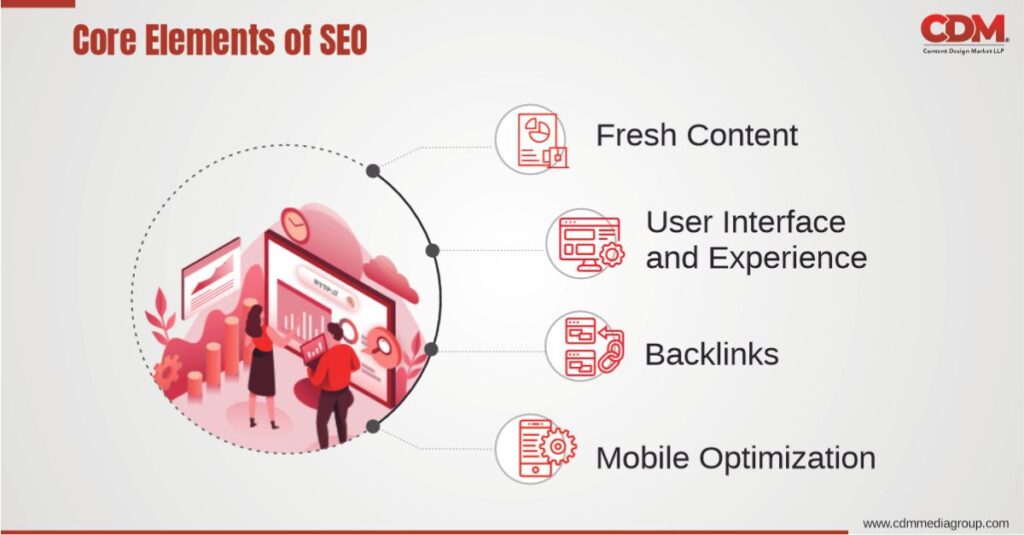When it comes to SEO rankings – everyone wants their webpage to be on the top. But the journey begins with first understanding what helps get to the top! As Google’s crawlers lurk through our content, and index our pages, we are constantly forced to ask, ‘What does the algorithm want’ or ‘what do the crawlers look at when indexing pages’?
Many may think of this as another one of the unsolvable and ever-evolving internet mysteries. But if you can somehow crack it, you can rule the SEO world!
The crawlers are designed to identify and index the information available on each page – these bits of information (graphics, content, links, etc.) become the key players that help in SEO rankings.
The purpose of these players (or attributes) may vary. For example, some could be responsible for answering questions or providing specific functionalities to enhance user experience and accessibility. Others might be involved in rewriting or completing certain sections of content.
The success of an SEO strategy depends on these players, their placement, and their use. In this article, let us put our detective hats on and try to finally understand how to beat the algorithm!
Here is what we know –
- Google evaluates sites based on hundreds of ‘players’ (or attributes), such as
- Purpose of the page
- Content quality and amount
- Website info and info about the content creator
- Website reputation and content creator reputation
- User interaction with the page (time on page, bounce rates, and so on)
- Google shows searchers the most relevant, high-quality results related to what they’re looking for.
Here in lies our first clue – adjusting our strategies according to what Google expects is our Achilles heel.
Asking the right questions – Google is not the consumer

Instead of solely relying on Google’s algorithms, we should prioritise understanding and catering to our potential consumers. By answering their questions, addressing their needs, and reaching out to them unassumingly, we can create a strong online presence that attracts and retains loyal customers. It’s all about putting the consumer at the centre of our digital strategies and providing them with the best possible experience.
So one of our major PLAYERS becomes the consumer themself! But one player can never be enough for a team game…
In the Google archives, we found a gem. Our second clue –
In August 2018, Google rolled out the “medic update,” which emphasised 3 factors:
expertise, authority, and trustworthiness, also known as E-A-T.
Provide Quality – Understanding E-A-T
Google knows that people rely on their platform for a wide range of topics, and they understand that if the wrong information shows up, it can have a negative impact on people’s lives. This is where we can find one of the major factors that affect ranking. Delivering reliable and trustworthy search results ensures your online experience is helpful and safe.
Google’s E-A-T is a framework used by Google to assess the quality and reliability of content on the web. It is crucial to determine how search results are ranked and displayed to users. Thus Google’s E-A-T becomes our next major PLAYER!
Let’s break down what E-A-T stands for
Expertise
Content that offers comprehensive, accurate, and easily understandable knowledge ranks higher.
Authoritativeness
When experts speak from conclusive evidence as well as industry experience, it adds authority to the content.
Trustworthiness
Content that is honest, transparent, and supported by reliable sources is deemed more trustworthy by Google.
Top Attributes Affecting SEO Ranking

Now that we have our two headlining players figured out, let us work on building our team’s strengths by adding more players to our list.
‘Fresh’ Content
Here it is important to add value, to each statement, and each example. The content that accurately answers a question and makes sure that the answer is simple to understand has the highest chance of ranking first.
Well-written articles, informative blog posts, and relevant website pages that address user queries and offer insightful information tend to rank higher. Incorporating relevant keywords, optimizing meta tags, and headers, and ensuring the content is well-structured and easy to read can further enhance its SEO performance.
This is why we at CDM train our writers to think before they write. Our editors don’t change the content, instead leave a comment which is then picked up by the writer. We want to create an environment that cultivates thought-out and researched pieces that are targeted toward specific goals and objectives.
Updating User Experience
Design drives the eye! Factors that influence UX include website load speed, mobile-friendliness, ease of navigation, clear and intuitive website design, and accessible content. Optimizing these aspects enhances user satisfaction, encourages longer visit durations, and reduces bounce rates, all of which contribute to improved SEO ranking.
We at CDM have found from our extensive experience that constant checks and updates are key to perfecting website UX. Aspects like the loading speed and webpage design need to be revised constantly to keep up with market trends.
The Technical Side
The technical aspects of a website greatly impact its search engine ranking. These include factors such as website crawlability, indexability, site structure, sitemap, URL structure, canonicalization, and proper use of tags (e.g., title tags, meta tags). Ensuring that search engines can easily crawl and understand the website’s content improves its visibility in search results.
The technical side of SEO may seem overwhelming, especially if you are someone who tends to stay away from all the tech jargon. But that’s why you have SEO – services offering companies who can cut up all the data into bite-sized reports for you. It is important to understand the basics and analyse them. Maybe get someone to help you with it. At CDM, we offer SEO services and ensure that we present the reports to our clients every month. This way we can answer questions and clarify points that may be difficult to understand.
It’s important to note that these players interact and influence each other. For example, high-quality content contributes to a positive user experience, and a well-optimized website structure improves content discoverability by search engines. By focusing on creating valuable content, optimizing user experience, and addressing technical aspects, website owners can improve their SEO ranking and visibility, driving more organic traffic to their sites.
CDM’s Tips and Value Additions
- Websites that are not mobile-friendly may experience lower visibility and rankings. We have experienced mobile customisations to be a big factor in user experience. Many times people look you up on their phones and a wonky website layout really pulls the joy out of the search!
- Page speed plays a significant role in both user experience and SEO ranking. Slow-loading websites can lead to higher bounce rates and lower search engine rankings.
We hope this sleuthing helps us all create content that leaves a high-ranking mark on the internet!
CDM wishes you the best of luck with your further quests!




